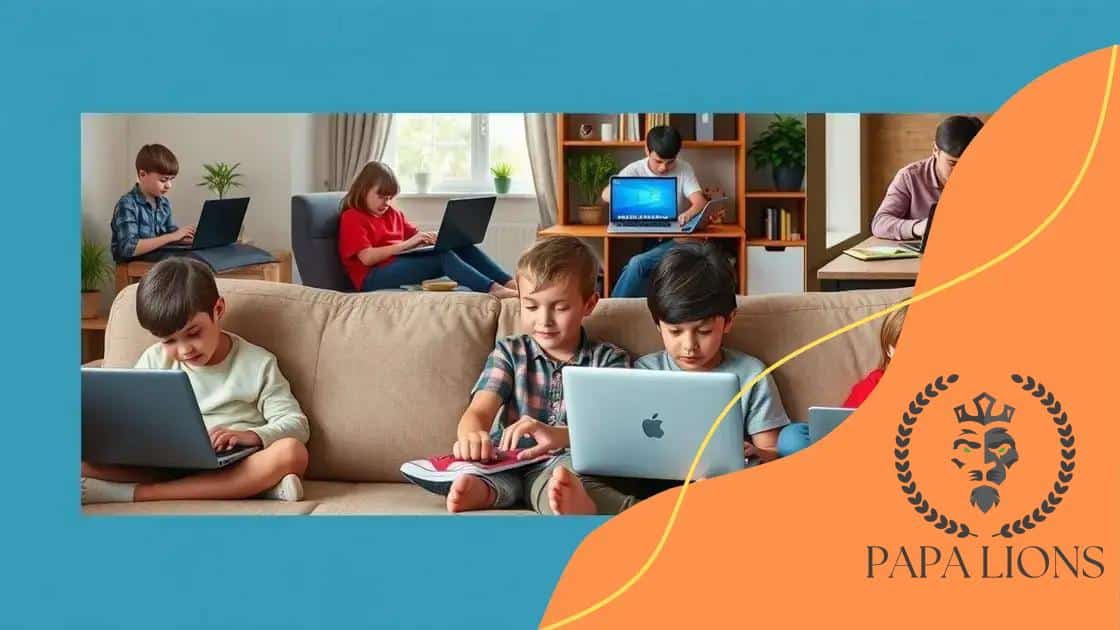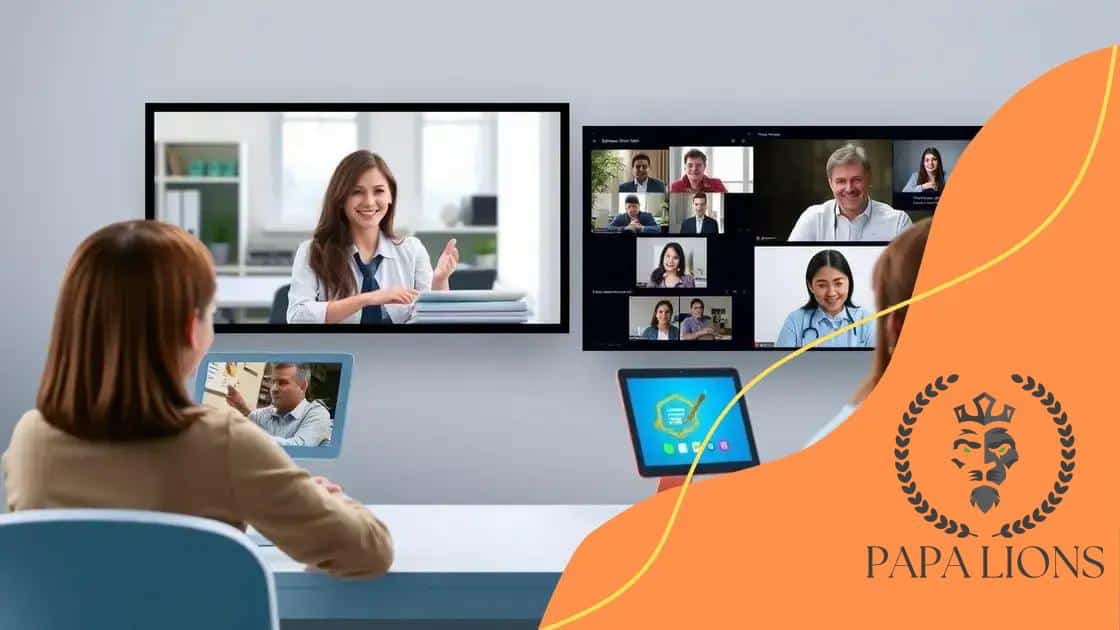Remote learning innovations that transform education

Remote learning innovations enhance education by incorporating technologies such as AI and virtual reality, providing flexible, personalized learning experiences while addressing challenges like motivation and access to technology.
Remote learning innovations have changed the educational landscape, making it more accessible and flexible for students. Have you ever wondered how these tools can enhance your learning experience? Let’s dive into the exciting developments taking place in this realm.
The evolution of remote learning technologies
The evolution of remote learning technologies has significantly influenced education across the globe. With advancements in internet connectivity and digital tools, learning has become more accessible than ever.
One of the key drivers of this change has been the rise of various online platforms designed to enhance the learning experience. These tools not only facilitate the exchange of knowledge but also foster community among learners.
Key Technologies in Remote Learning
Several technologies have played a crucial role in shaping modern education. Among them, video conferencing tools and learning management systems are especially noteworthy.
- Video Conferencing: Platforms like Zoom and Microsoft Teams enable real-time interaction, bringing teachers and students together regardless of location.
- Learning Management Systems: Systems such as Moodle and Canvas help organize course materials and track student progress.
- Interactive Tools: Resources like Kahoot and Quizlet engage students through quizzes and games.
- Virtual Reality: Emerging VR technologies provide immersive experiences for subjects like science and history.
These tools not only enhance learning but also provide flexible options for students. As technology continues to advance, educators are exploring new ways to integrate innovative tools into their teaching methods.
The increased reliance on smartphones and tablets has further transformed how learners approach their education. With access to information at their fingertips, students can engage with materials anytime and anywhere.
Challenges and Innovations
Despite the benefits, there are challenges to overcome, such as ensuring equal access to technology for all students. Innovations are being developed to address these issues, aiming to create more inclusive environments.
In conclusion, the evolution of remote learning technologies is an ongoing journey. By embracing these advancements, educational institutions can create engaging and adaptable learning experiences for all students.
Key benefits of remote learning innovations
The key benefits of remote learning innovations are transforming how students and teachers interact. These advancements make education more accessible and customizable.
By utilizing technology, remote learning allows students to participate from anywhere, whether at home or on the go. This flexibility enables learners to manage their time better, balancing study with other commitments.
Enhanced Flexibility
One of the biggest advantages is the flexibility it offers. Students can learn at their own pace, revisiting materials as needed to grasp difficult concepts.
- Self-Paced Learning: Students can pause lectures and review content to improve understanding.
- Customizable Schedule: Learners can organize their study time around other responsibilities like work or family.
- Remote Access: Education is available to anyone with internet access, expanding opportunities for diverse populations.
This approach also encourages the development of essential skills like self-discipline and time management. As students navigate their online courses, they foster independence in their education.
Increased Engagement
Furthermore, remote learning technologies often include interactive tools that promote a more engaging learning environment. For example, platforms can feature gamified lessons, encouraging participation and making learning fun.
Students can also interact with peers and educators in real-time, fostering a sense of community. These connections help to enhance understanding and retention of material, as discussions can lead to deeper insights.
Lastly, the integration of multimedia resources allows for varied learning styles, accommodating visual, auditory, and kinesthetic learners. This inclusivity ensures that everyone’s needs are met effectively.
Best practices for engaging remote learners

Engaging remote learners effectively is crucial for ensuring they receive a quality education. Implementing best practices for engaging remote learners can make a significant difference in student outcomes.
First, clear communication is essential. Instructors should provide regular updates and feedback, making students feel connected and informed. Using multiple channels, such as emails, discussion boards, or chat platforms, can enhance this connection.
Interactive Learning Techniques
Another effective strategy involves incorporating interactive learning techniques. These allow students to engage actively with the material and with each other.
- Live Discussions: Regularly scheduled video calls can facilitate live discussions where students can ask questions and share thoughts.
- Group Projects: Assigning students to work in small groups promotes collaboration and helps build a sense of community.
- Quizzes and Polls: Using quizzes and polls during lessons keeps learners attentive and provides immediate feedback.
- Gamification: Adding game-like elements can make learning more enjoyable, motivating students to participate.
Moreover, providing varied content formats such as videos, podcasts, and readings caters to different learning preferences. This variety helps keep the material fresh and engaging.
Establishing Routines
Establishing consistent routines can also boost engagement. When students know what to expect, they are more likely to stay focused and organized. A well-structured schedule that includes regular breaks can improve productivity.
Teachers can foster connections by creating opportunities for students to share their experiences. This can be done through social media groups or forums where students can discuss personal interests related to the course material.
Lastly, recognizing student achievements can build motivation. Acknowledging progress, no matter how small, encourages students to stay dedicated to their learning journey.
Challenges faced in remote learning environments
Remote learning environments present several unique challenges that can impact student success. Understanding these challenges is essential for developing effective solutions.
One significant issue is the lack of motivation among students. In a traditional classroom, the presence of teachers and peers can inspire engagement. However, when learning remotely, students may struggle to stay focused without that physical presence.
Technical Difficulties
Another common challenge is related to technology. Not all students have access to reliable internet or devices suitable for learning, which can create disparities.
- Internet Connectivity: Many students may live in areas with poor internet access, making it difficult to participate in online classes.
- Device Availability: Some students may not own laptops or tablets, hindering their ability to complete assignments effectively.
- Technical Skills: Students and educators alike may lack the necessary skills to navigate online learning platforms.
Additionally, the feeling of isolation can affect student well-being. Without regular interactions with their peers and teachers, many students may experience loneliness and disconnect.
Distractions at Home
Distractions at home also pose a significant challenge. In a traditional classroom, the learning environment is structured. However, at home, students may face interruptions from family members, siblings, or other obligations.
These distractions can lead to decreased attention and productivity. Some students may find it hard to separate their home life from their school responsibilities.
Finally, assessments in remote learning can be tricky. Ensuring academic integrity is crucial, yet it can be challenging to monitor during online tests. Educators must come up with creative solutions to handle this issue while maintaining fairness.
Future trends in remote education
The future trends in remote education indicate a significant shift toward more engaging and effective learning experiences. As technology evolves, education is likely to become even more adaptive and personalized.
One major trend is the increasing use of artificial intelligence (AI). AI can help tailor learning experiences to each student’s needs. By analyzing performance data, AI can suggest resources and strategies that fit individual learning styles.
Hybrid Learning Models
Another important development is the rise of hybrid learning models. These combine both in-person and online education, providing students with the flexibility to choose their learning environment. This approach allows for a more balanced educational experience.
- Flexibility: Students can attend classes either in person or virtually, depending on their preferences.
- Personalization: Increased opportunity for customized learning paths that match students’ interests and abilities.
- Community Building: In-person sessions foster a sense of belonging and community among students.
Furthermore, the incorporation of virtual reality (VR) and augmented reality (AR) technologies can create immersive learning experiences. Imagine exploring historical sites or conducting science experiments in a virtual lab without leaving your home.
Focus on Social-Emotional Learning
Another trend is a greater emphasis on social-emotional learning (SEL) within remote education. Schools will focus on developing students’ emotional intelligence and interpersonal skills through online platforms. This holistic approach supports both academic and personal growth.
Additionally, online collaboration tools will continue to improve, allowing for more effective group projects and discussions. These tools enable students to work together seamlessly, regardless of their physical location. They facilitate peer engagement and foster a collaborative spirit, essential for modern education.
In summary, the landscape of remote education is changing rapidly. By embracing advanced technologies and innovative teaching methods, educators can create engaging, inclusive, and effective learning environments for all students.
FAQ – Frequently Asked Questions about Remote Learning Innovations
What are the key benefits of remote learning?
Remote learning offers flexibility, accessibility, and the ability to tailor learning experiences to individual needs.
How can technology enhance remote education?
Technology, such as AI and interactive tools, can create engaging and personalized learning environments, helping students succeed.
What challenges do students face in remote learning?
Students may struggle with motivation, access to technology, and distractions at home, making effective engagement essential.
What trends are shaping the future of remote education?
Future trends include hybrid learning models, increased use of virtual reality, and a strong focus on social-emotional learning.





